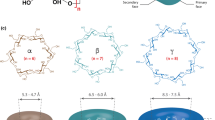Abstract
In this study, the synthesis of cyclodextrin-based hyperbranched polyester (CD-based HBPE) was prepared by a simple condensation route via acid chloride approach (Scheme 1). The formation of ester linkages in CD-based HBPE was clearly identified from FTIR and NMR spectroscopy. The resulting structure and the molecular weight of the CD-based HBPE were confirmed with LC–MS analysis. The CD-based HBPE displayed the fluorescence maxima in the 425 nm range with relatively narrow peak widths indicating that they had pure and intense fluorescence. The antimicrobial activity of the CD-based HBPE was evaluated against the Gram-negative organisms like Escherichia coli and Salmonella paratyphi, Gram-positive organisms as Bacillus subtilis and Staphylococcus aureus and fungi such as Aspergillus niger, and Candida albicans. CD-based HBPE showed a great inhibitory effect toward both bacteria and fungi. The microorganism which possess greater antimicrobial activity with standard antibiotics was selected for determining the minimum inhibitory concentration (MIC) value of the CD-based HBPE. Therefore, the MIC value of the CD-based HBPE against B. subtilis was tested and found to be 31.25 μg mL−1. Hence, it is suggested that CD-based HBPE holds good agreement with the antimicrobial assay.







Similar content being viewed by others
References
Qian, L, Guan, Y, Ziaee, Z, He, B, Zheng, A, Xiao, H, “Rendering Cellulose Fibers Antimicrobial Using Cationic β-Cyclodextrin-Based Polymers Included with Antibiotics.” Cellulose, 16 309–317 (2009)
Rong, L, Jianfeng, D, Qianyuan, J, Jing, L, Zhiwei, X, Jie, L, Xuehong, R, “Preparation and Antimicrobial Activity of β-Cyclodextrin Derivative Copolymers/Cellulose Acetate Nanofibers.” Chem. Eng. J., 248 264–272 (2014)
Chao, D, Ying, Y, Liying, Q, Guanglei, Z, Beihai, H, Huining, X, “Antibacterial Modification of Cellulose Fibers by Grafting β-Cyclodextrin and Inclusion with Ciprofloxacin.” Cellulose, 21 1921–1932 (2014)
Zeynep, A, Sema, YD, Turgay, T, Tamer, U, “Release and Antibacterial Activity of Allylisothiocyanate/β-Cyclodextrin Complex Encapsulated in Electrospun Nanofibers.” Colloid Surface B, 120 25 (2014)
Martin Del Valle, EM, “Cyclodextrins and Their Uses: A Review.” Process Biochem., 39 1033–1046 (2014)
Jozsef, S, “Introduction and General Overview of Cyclodextrin Chemistry.” Chem. Rev., 98 1743–1753 (1988)
Allan, RH, “Industrial Applications of Cyclodextrins.” Chem. Rev., 98 2035–2044 (1998)
Veronique, W, Anne-Magali, L, Dominique, H, Catherine, A, “Cyclodextrin Polymer Nanoassemblies: Strategies for Stability Improvement.” Biomacromolecules, 13 528–534 (2012)
Olga, J, Adam, M, Rebecca, S, Helmut, R, “Cyclodextrin-Modified Polyesters from Lactones and from Bacteria: An Approach to New Drug Carrier Systems.” Macromolecules, 44 1365–1371 (2011)
Wei, T, Xiaodong, F, Jie, K, Tao, L, Yuyang, L, Yi, H, Shengjie, W, Guobin, Z, “Cyclodextrin-Based Hyperbranched Polymers: Molecule Design, Synthesis, and Characterization.” Macromolecules, 42 640–651 (2009)
Qian, L, Guan, Y, Xiao, H, “Preparation and Characterization of Inclusion Complexes of a Cationic β-Cyclodextrin Polymer with Butylparaben or Triclosan.” Int. J. Pharm., 357 244–251 (2008)
Akira, H, Masaoki, F, Shun-ichi, N, “Cooperative Binding by Cyclodextrin Dimers.” Polym. J., 12 29–33 (1980)
Akira, H, Masaoki, F, Shun-ichi, N, “Inclusion of Aromatic Compounds by a β-Cyclodextrin-Epichlorohydrin Polymer.” Polym. J., 13 777–781 (1981)
Jianshu, L, Huining, X, Jiehua, L, YinPing, Z, “Drug Carrier Systems based on Water-Soluble Cationic β-Cyclodextrin Polymers.” Int. J. Pharm., 278 329–342 (2004)
Makvandi, P, Ghaemy, M, Ghadiri, AA, Mohseni, M, “Photocurable, “Antimicrobial Quaternary Ammonium–modified Nanosilica.” J. Dent. Res., 94 140–146 (2015)
Clinical and Laboratory Standards Institute, “Method for Antifungal Disk Diffusion Susceptibility Testing of Yeasts.” Approved Guidelines—second edition. (2009). http://shop.clsi.org/site/Sample_pdf/M44A2_sample.pdf. Accessed 28 Aug 2009
Prudencio, A, Schmeltzer, RC, Uhrich, KE, “Effect of Linker Structure on Salicylic Acid-Derived Poly(anhydride-esters).” Macromolecules, 38 6895–6901 (2005)
Thiyagarjan, S, Sivakumar, C, Sultan, N, “Hydroxyl-Terminated Hyperbranched Aromatic Poly(ether-ester)s: Synthesis, Characterization, End-Group Modification, and Optical Properties.” J. Polym. Sci. Pol. Chem., 46 5414–5430 (2008)
Sivakumar, C, Sultan, N, “Hydroxyl- and Amine-Terminated Hyperbranched Polyurethanes Using AB2-Type Azide Monomers: Synthesis, Characterization, Fluorescence, and Charge-Transfer Complexation Studies.” J. Polym. Sci. Polym. Chem., 47 3337–3351 (2009)
Chen, JW, Peng, H, Law, CW, Dong, YP, Lam, JWY, Williams, ID, Tang, BZ, “Hyperbranched Poly(phenylenesilolene)s: Synthesis, Thermal Stability, Electronic Conjugation, Optical Power Limiting, and Cooling-Enhanced Light Emission.” Macromolecules, 36 4319–4327 (2003)
Peng, H, Cheng, L, Luo, J, Xu, K, Sun, Q, Dong, Y, Salhi, F, Lee, PPS, Chen, J, Tang, BZ, “Simple Synthesis, Outstanding Thermal Stability, and Tunable Light-Emitting and Optical-Limiting Properties of Functional Hyperbranched Polyarylene.” Macromolecules, 35 5349–5351 (2002)
Jenekhe, SA, Osaheni, JA, “Excimers and Exciplexes of Conjugated Polymers.” Science, 265 765–768 (1994)
Xianzhen, L, Wenjin, Z, Yong, Z, Qioong, H, Wei, Y, Yong, C, “Synthesis and Properties of Novel Poly(p-phenylenevinylene) Copolymers for Near-Infrared Emitting Diodes.” Eur. Polym. J., 41 2923–2933 (2005)
Ye, Y, Ren, H, Zhu, S, Tan, H, Li, X, Li, D, Mu, C, “Synthesis of Oxidized β-Cyclodextrin with High Aqueous Solubility and Broad-Spectrum Antimicrobial Activity.” Carbohydr. Polym., 177 97–104 (2017)
Karpagam, S, Guhanathan, S, “Phosphorus Based Indole and Imidazole Functionalized Hyperbranched Polyester as Antimicrobial Surface Coating Materials.” Prog. Org. Coat., 77 1901–1910 (2014)
Kenawy, ER, Worley, SD, Broughton, R, “The Chemistry and Applications of Antimicrobial Polymers: A State-of-the-Art Review.” Biomacromolecules, 8 1359–1384 (2007)
Acknowledgments
The authors gratefully acknowledge the Sri Krishna College of Technology and Bharathiar University for their constant support.
Author information
Authors and Affiliations
Corresponding author
Electronic supplementary material
Below is the link to the electronic supplementary material.
11998_2017_41_MOESM5_ESM.eps
Fig. S3 Cyclic voltammograms of the CD-based HBPE in toluene/acetonitrile (v/v 8:2) containing 0.1 M TBAP at a scan rate of 10 mV/s, vs Ag/AgCl (EPS 730 kb)
Rights and permissions
About this article
Cite this article
Prabu, S., Sivakumar, C. Cyclodextrin-based hyperbranched polyester: synthesis, characterization, and antimicrobial activity. J Coat Technol Res 15, 1059–1066 (2018). https://doi.org/10.1007/s11998-017-0041-4
Published:
Issue Date:
DOI: https://doi.org/10.1007/s11998-017-0041-4




